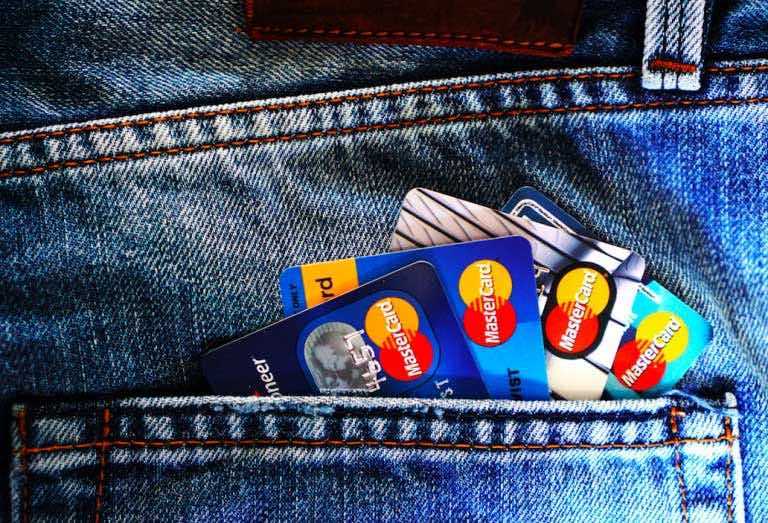How to Choose A Credit Card
Applying for credit cards isn’t something to take lightly! Here are just a few things to consider if you’re in the market for a new card.
- Applying can affect your credit score. On average, applying for a traditional credit card temporarily drops your score by up to five points, regardless of whether you’re approved or not.1 Though this drop is usually short-lived, you should still be wary of applying for too many credit products at once and avoid applying for cards you likely won’t be approved for.
- Interest rates vary from one card to the next. Interest costs can add up quickly; according to CardRates, the average credit card interest rate is nearly 15%.2 This is one of the biggest reasons why you need to be careful with credit cards.
- Some credit cards carry hefty costs. In addition to interest, many credit card companies charge extra fees to apply for, keep, and/or use the card.
All this considered, you need to be careful and strategic in your application decisions! We’ll show you how to find the right card for your needs, lifestyle, and spending habits. It's a four-step process of evaluating your credit score, considering your needs and plans, discovering the total cost of a card, and finally, applying with care.

Evaluate Your Credit Score
Your credit score is a three-digit number that lenders use to predict your ability to repay what you borrow. It’s composed of many elements, with top influencing factors including your payment history, how much credit you’re currently using, the length of your established credit history, the different types of credit you’ve utilized, and any new credit inquiries you’ve made recently. Since your credit score matters to most lenders, it can affect what you get approved for, as well as the terms of your approval.
What Is a “Good” Credit Score?
On the standard score measuring scale of 300 to 850, a score between 658 and 719 is considered “good” and 720 or above is considered “very good” or “excellent.” The higher your credit score is, the better your chances are of being approved for credit and receiving favorable borrowing terms.
Most lenders view a score of 657 or lower as “subprime.” Consumers with a "subprime" score may be offered a smaller credit limit, owe extra fees, and/or pay more in interest than their "prime" counterparts.
Where to Find Your Credit Score
You’re entitled to one free copy of your credit report each year from any of the major credit bureaus (i.e. Experian, Equifax, and TransUnion.) But to access your credit score any time, get our Credit Health tool! We’ll put awareness and control of your credit right at your fingertips.
Once you understand your credit score and the options available to an applicant at your credit level, it’s time to think about what you plan to do with your credit card.
Consider Your Needs and Plans
Before applying for a new credit card, make sure you’re clear about why you’re getting one in the first place. Common credit card uses include:
- Building credit
- Everyday shopping
- Earning rewards
- Covering financial emergencies
- Paying for a major purchase or project
- Transferring balances or finding a lower interest rate
Ask yourself, “how much do I need to borrow?” The answer to this will depend on whether you need to finance a single purchase and/or project, or want financing you can use sporadically across a longer period of time. You might also consider any potential credit card rewards and how they can help you achieve your goals.
Think About Potential Rewards
Many credit cards offer rewards, or incentives for using them and/or making payments. They commonly take the form of cash rewards cards, store credit cards, and travel rewards cards.
As we dive into each of these in more detail, keep in mind that some cards might come with hefty fees and/or high interest rates. And since these cards are often tailored to people with high credit scores, carefully review any approval criteria before applying.
Cash Rewards Cards
Cash rewards cards, as the name suggests, give you cash back when you use them. These rewards are usually between 1 and 2% (or $1 to $2 back for every $100 you spend); but some offer bigger incentives. They’re a great choice if you’re looking for a card you can use every day and pay off regularly.
Store Credit Cards
Many popular retailers have their own credit cards that offer “cash back” in the form of store credit. There are two types of store credit cards: “open-loop,” which can be used anywhere traditional cards (i.e., Visa, Mastercard, American Express) are accepted, and “closed-loop,” which can only be used at the store that issued the card.
If you struggle with resisting the urge to splurge, a closed-loop card from a favorite retailer could strike the balance between rewarding you and encouraging responsible shopping. If you’re more confident in your impulse control, an open-loop store card can help you earn free products and services no matter where you shop.
Travel Rewards Credit Cards
Globetrotters across the world enjoy the perks of travel rewards cards. These cards offer “miles,” which you can redeem for flights, or “points,” which you can redeem for other expenses associated with travel, such as hotel stays. If you’re a frequent traveler, a travel rewards card can help offset the cost of your trip!
The best rewards can boost your budget by offering free items or extra money for doing things you’re already doing, so evaluate your options closely and choose rewards that match your lifestyle, habits, and priorities.
Discover the Total Cost of a Card
Credit cards allow you to pay for an item or service upfront without an immediate hit to your bank account. This is convenient and, for many of us, necessary for getting the things we need - but it comes with additional costs you need to be aware of. On top of whatever you charge to a card, you may end up owing interest and additional credit card fees.
Examine Interest Rates
It’s no secret that credit card debt can add up fast. Save yourself money and stress by learning what interest rates are available to you and choosing the best of your available options.
Understand the Difference Between APR and Interest Rates
When you’re examining different credit card offers, you’ll likely come across two terms: interest rates and annual percentage rates (APR). While these things are closely related, there are a few key differences. Understanding these differences will help you get the best rates possible.
- An interest rate is the amount of interest a lender charges in exchange for letting you borrow money from them.
- Annual percentage rate, or APR, refers to the total cost of borrowing money for a year. It includes all interest calculated over the year, plus any extra fees assessed during that period. Note that if your credit card doesn’t have any fees, your APR and the amount you pay in interest per year will be the same.
See What Rates You Qualify For
The interest rates available to you will depend on a handful of factors.
- Your credit score: Most lenders use your credit score to predict whether you’ll be able to repay what you borrow. Borrowers with a lower credit score represent a higher credit risk, while those with “good” or “excellent” credit are viewed as safer to lend to; therefore, the better your credit score, the lower your interest rate will likely be, since the lender won’t be as concerned about your ability to repay your debts.
- The card type: Some types of cards have higher interest rates than others. For example, rewards cards typically have higher interest rates to make up for the expense of offering the rewards, and credit-building cards generally have higher rates since their customers present a bigger risk compared to other groups.
- Your payment history: Some cards carry penalty rates, or a higher interest rate they’ll charge if you make a late payment (or miss a payment entirely.) Read the fine print of any credit card agreement to see if the card comes with a penalty rate.
Since you may not know your interest rate until you’ve already applied for a card, use these stats to better predict and prepare for the terms you’ll be offered.3
| Credit Score | Average Credit Card Interest Rate |
|---|---|
| 740 or higher | 15% - 22% |
| 670 - 739 | 15% - 24% |
| 669 or lower | 20% - 26% |
If you plan to carry a balance over the long term, choose a card with a fixed interest rate. These stay consistent, as opposed to variable rates which fluctuate based on market conditions. This can save you hundreds or even thousands in interest over time.
Watch Out for Additional Fees
We’ve talked a lot about interest rates and how they can expand your debt, eat into your savings, and overall deplete your bank account. But some credit cards accrue fees above and beyond interest. Common credit card fees include:
- Annual fees, or a yearly fee you pay to continue holding and using the card.
- Late fees, or a charge you pay if you don’t make a payment by its due date.
- Cash advance fees, which are assessed when you move money from your credit line into a checking account.
Apply with Care
The right credit card for you depends on many factors, including your credit score, your immediate plans, and your long-term financial goals. Especially if you plan to have multiple credit cards eventually, be strategic about what you apply for and when, and make sure to spread your applications out so your credit score doesn’t take too much of a hit.
If you need somewhere to begin, learn about our different Upgrade Card options! Applying for Upgrade Card doesn’t affect your credit score unless you’re approved for and accept the card, so you can apply with peace of mind.


